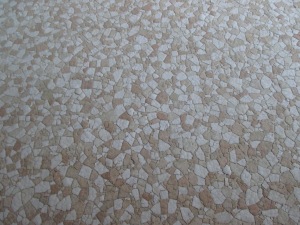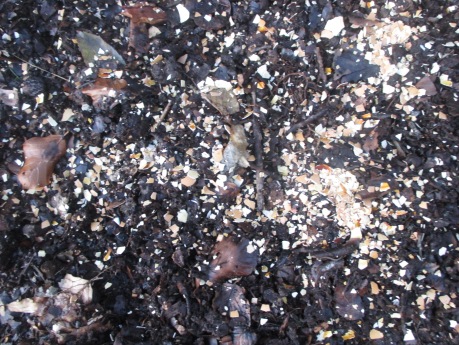
We had our family-and-friends Thanksgiving feast not on Thanksgiving this year, but last Saturday. Beautiful, and hard work, and I’m glad to have done it, because a holiday of gratitude is a tradition to honour. And yet, while as a foodie I get really excited by all the chatter in the blogosphere about The Meal, the lavishness, excess, and gluttony sit uncomfortably. There’s something disgusting about eating to overfulness, on a personal, physical level as well as the obvious political ramifications– and so many hungry in our communities, our countries, our globe. I think next year I will work harder for a food aesthetic that feels harvesty and celebratory yet simple, with an enough-ness to the gratitude. Is “ample sufficiency” the phrase I’m seeking?
And there’s the history of this holiday, the violence, which I’ll leave alone for this moment– the kind of history that is on my mind, filled with sadism of the White Victor towards the natives, horrendous– doesn’t quite match the instagrammatic filters of sugar-glistening pastry and home-sweet-home nostalgia. But had to say — I’m me LOL!
The pie I made for our feast: a beautiful Apple and Salted-Caramel Pie from the new cookbook from the Four and Twenty Blackbirds Pie people in Brooklyn–which recipe I found on the internet. It came out really well even with my substitutions (pear scrap-vinegar instead of lemon juice), though quite wet and way too sweet for my taste — and I was reminded how if I can keep internalising intuitive approaches to baking as I have cooking, I’ll be a better and better baker. In other words: I want to reduce my recipe reliance– in other words, to use recipes for ideas but not to need them, or rather, to be able to do without them.
So here I go trying to explain this, because I think it’s useful to articulate, and the next day. with the conscious intention to learn from doing, I actually made a better pie of my own invention, and I learned principles from it that I now can grow with. I want to have this as a reference for the future.
To start with, I had extra dough, and I had found this, and it was indeed perfect “Perfect Pie Crust.”
http://www.simplyrecipes.com/recipes/perfect_pie_crust/
Though “perfect” (a concept I dislike) is as much about technique (very light handling) and letting the dough rest between mixture and rolling, as anything else. Oh, freshness of butter maybe!
I used a combination of flours: local wholemeal (not strong) which I love for baking, Gluten Free White Flour, Cheap White Flour, Expensive Organic White Spelt. I always mix flours, usually to a browner effect, often with almond meal, or chestnut flour, or maize, or buckwheat– and I’ve learned to feel free doing this. You get used to feeling of moistness how much cold water you need to add — add very little, then add a little more. And if it’s too wet by unfortunate miscalculation, you can roll out the dough with a little extra flour to compensate– and don’t stress– it will still be good enough. Because you are liberated from the idea of Perfect with the idea Beautiful and Creative. Eventually, your doughs will have the right fat/wet/dry balance just from experience.
(Here’s the link to advertise some wonderful, relatively local Welsh flour: http://www.talgarthmill.com/talgarth-mill-flour/ )
So the intention was to make an apple pie:I cut up apples, meaning, removed damaged skin, cored, all the ugly bits (am still working through boxes of windfalls that by now are really needing to be used)– and had a nice bowl of apples. I added a happy tablespoon of cinnamon, a scant quarter cup of sugar, and maybe two spoons of flour– of course could be ground almonds, or cornflour, or teeny tapioca pearls– but a thickener. And I let it sit to see how much water would come out. The extra flour mattered this time. Wet is best if syrupy in pies. How’s that for a dictum?
Then the brain wave came to add the leftover cranberry-orange sauce, sitting right in front of me in a glass jar I’d meant to put in the fridge. This is the cranberry sauce I most like making– the one I learned through all my childhoods, Thanks Mom!, printed on that plastic bag packet– mix a pack of cranberries, two organic oranges, a quarter cup of sugar, for a tart, invigorating, raw “relish.” So mixed it with the apples, rolled out the bottom layer of the dough, put the fruit in, and covered with a sloppy looking lattice, then rolled the last of the dough into hearts to decorate and disguise my lazy handiwork.
I felt proud of this pie because it was my own. And not too sweet, slightly tart, slightly sour, a beautiful colour, and I gave it to a good friend who is having a challenging time– hoping she’d eat it for breakfast, because pie for breakfast is love. The love is part of the non-recipe recipe. I hope this all makes sense.
And there’s a dessert post, if a little convoluted, in advance of American Thanksgiving, for the friend of the friend who asked.









